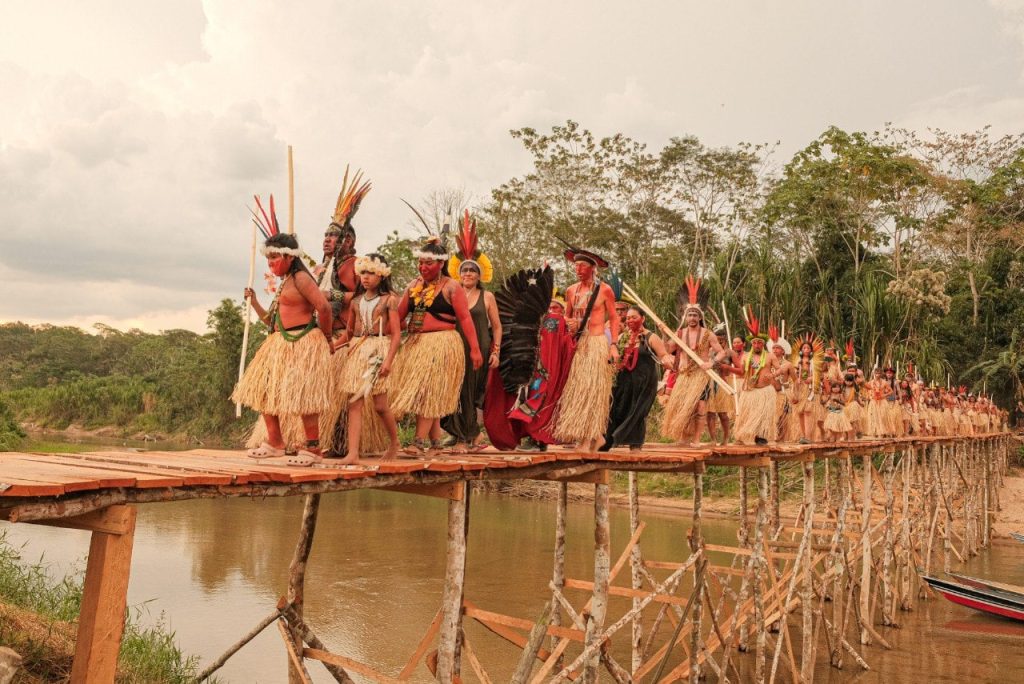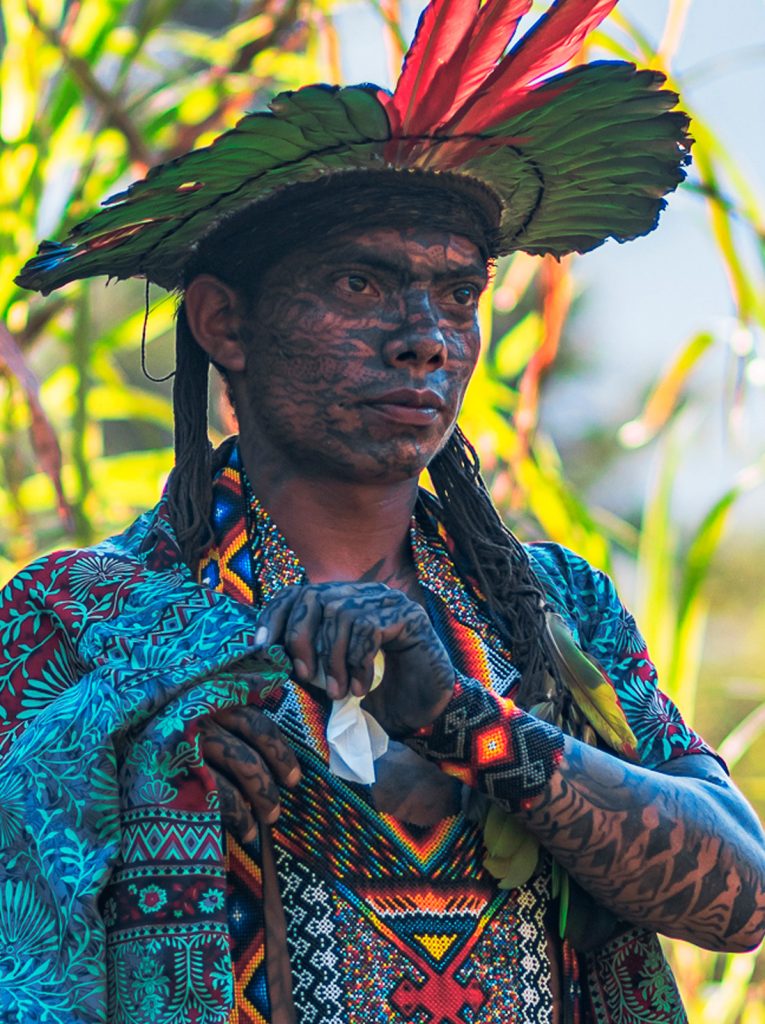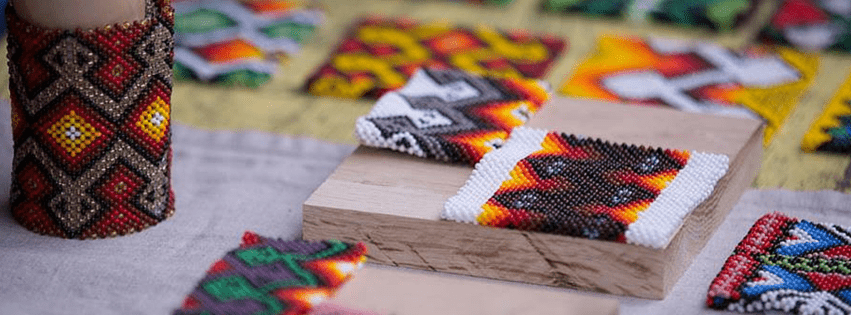Festivals and Ceremonies
Festivals are especially important for establishing and strengthening sociopolitical relations between the Yawanawá themselves and other groups.
Saiti (‘sai’ means to shout) is the Yawanawá word that generically designates ‘festival,’ and ‘Mariri,’ which is not a Yawanawá word, is also used by other groups in the region.

The ‘uma aki’ (‘caiçuma’ festival, a type of cassava chicha) lasts several days and focuses on intergroup relations, as it generally includes participants from other communities. This ritual involves several sequences, some of which may appear in isolation in smaller festivals: games, caiçuma drinking and purging, war reenactments, dances, and songs.
With the unfolding of territorial demarcation, the awareness of Indigenous rights beginning in the 1980s, and the new possibilities for obtaining resources from the ecological movement, the Yawanawá began revitalizing their traditions and culture in the 1980s.
In 2000, they created the Mariri Yawanawá Festival, which seeks to preserve the people’s culture and traditions. This festival brings together 17 villages and lasts about a week of songs, dances, ceremonies, and games. It is open to a limited number of tourists.
It is celebrated in the Sacred Village, the oldest of the Yawanawá communities, because it is where the sacred place is located where the grandparents (the shamans) built the place where the grandmother’s “ayahuasca” was cooked.

That same place later became the grandparents’ cemetery. This gives the medicine there an even greater potency. This is also where the great tree and the great vine used to prepare the sacred medicine are found.
In the Sacred Village, you can find a medicinal herb garden, an ayahuasca plantation, solar panels that illuminate the village at night and pump water from the river, cabins set up for diets and spiritual retreats, small beaches on the river, a sacred cemetery, a satellite dish that broadcasts live information for a digital art project, and new homes under construction.
In front of the community house where young people gather at night to rehearse music, there is a circular space the size of half a soccer field, bordered by a giant snake. It is a magical place of connection with Mother Earth, the Great Mystery, and the Great Forest.
A European visitor who attended this festival a few years ago tells us: “It’s during festivals like this that the village opens its doors to outsiders. At five in the morning, the jungle awakens, and with it all the members of the tribe.
They went to the river to bathe, cooked, and gave us short tours of the jungle surrounding the village to proudly show us the different properties of each plant. At night, they lit a fire and many sang with their guitars.
They go to sleep very early, after the sun sets. The work is divided among families. Many of them make incredible handicrafts. They usually use multicolored beads to draw jungle animals, such as parrots, pumas, jaguars, and snakes. These are protective crafts.
These crafts are then sold in larger cities or abroad. There are some who don’t have any specific activities during the day. The festival is free, and you must be invited by someone from the village or tribe to attend. All the visitors, however, participated in the purchase of a multitude of handicrafts as a thank you for their invitation.”

In 2002, the Yawa Festival was inaugurated in the village of Nova Esperança. It is an event that aims to introduce and share the Yawanawá culture with other Amazonian tribes, as well as with all people, regardless of ethnicity or nationality, who are interested in learning more about their worldview.
This grand gathering in Nova Esperança is a highly expressive moment for the Yawanawá, claiming the rescue, rebirth, and revitalization of their culture. The festival celebrates the prosperity of new times in contrast to the previous period of conflict, family dispersion, hardship, and oppression.
The celebration takes place in October and lasts five days. Several groups from urban centers arrive in the Indigenous territory to witness and participate in this event. The Indigenous people decorate the temples with paintings and explain their meaning.
Some days, at night, there are rituals with romë and uni (Ayahuasca). There are specific moments when local leaders offer speeches about indigenous culture, highlighting the revitalization process of the Yawanawá culture.
Nova Esperança Festival
The shaman and companion of leader Bira, organizes spiritual retreats for people who come from all over the world. This type of tourism, based on Yawanawá ritual practices for therapeutic purposes, is an important source of income for them, as is “ethnic” tourism.
Dancing and singing the “saiti,” learning about their origins, and drinking “uni” are things the Yawanawá people share with their foreign visitors during these festivities. In speeches during the festival, the story is presented as a cultural rebirth, an affirmation of identity and politics.
While at first glance the label “ethnotourism” may give the event a specific appearance, most visitors, as well as the natives themselves, understand the festival as something very different from tourism.
There is a search among visitors for an ecological philosophy: “Indigenous peoples or ethnic or cultural minorities from the four corners of the earth are seen as custodians of traditional knowledge regarding their environment, and as ethical and technical alternatives to the modern economic model,” and thus “Indigenous Peoples” is a term related to respect for Mother Earth.
For some Yawanawá, these festivals are not far removed from the gatherings that brought together only the peoples of the region. It is a space where they share their way of life with visitors. Shamanic knowledge and techniques relate to the relationship with the yuxin, the spirits who inhabit the forest and interfere in human life.
Cultural Expansion of Ayahuasca
Years ago, grandmother ayahuasca expanded its boundaries, was interpreted through other ways of understanding the experience, and emerged from the Amazon rainforest. Currently, this practice is expanding as a global movement, centered between the Americas and Europe, heterogeneous in its forms of expression.
The era of communication and social media is emerging, expanding its boundaries, especially through virtual means. The Yawanawá people participate in the expansion of human consciousness by taking this plant in festivals or ceremonies across the five continents.
